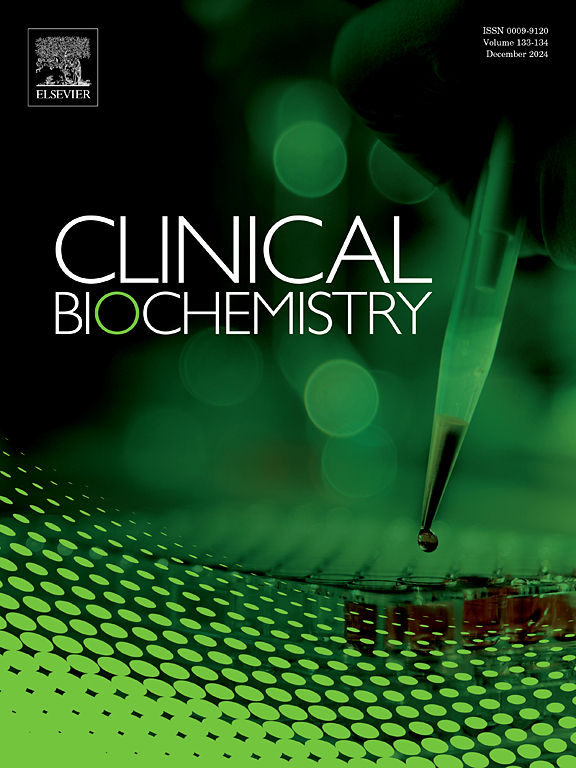Performance of the Siemens’ thyroid stimulating immunoglobulin assay in the diagnosis of hyperthyroidism: Prospective cohort study
IF 2.1
3区 医学
Q2 MEDICAL LABORATORY TECHNOLOGY
引用次数: 0
Abstract
Background
Auto-antibody testing is recommended for Graves’ Disease (GD). The thyroid-stimulating-immunoglobulin (TSI) bridge method is designed to provide specificity for stimulatory antibodies to the TSH receptor which may translate to differences in performance in diagnosis of GD compared to TSH-receptor-antibody (TRAb) assays that don’t distinguish between TSH-receptor antibody subclasses. The objective of this study was to prospectively compare the performance of a TSI assay to a TRAb assay for diagnosis of GD.
Methods
A total of 158 non-pregnant patients with new-onset hyperthyroidism were recruited into the study by endocrinologists. Final diagnosis of GD or non-GD was made by endocrinologists after clinical assessment and diagnostic work-up (TSH, free T4, TRAb and imaging). TSI results were blinded. Sensitivity/specificity of TRAb and TSI were determined; receiver operating characteristic (ROC) curve analysis was used to compare overall accuracy and optimal diagnostic thresholds for each assay.
Results
Complete assessment was available for 131/158 patients (95 GD and 36 non-GD). A strong correlation between TRAb and TSI existed (r = 0.92 (0.89–0.94), p < 0.0001). There was no significant difference between tests, area under the curve (AUC) (0.935 vs 0.929, p = 0.86) using manufacturer’s recommended thresholds. Both assays had sensitivity around 88 % and specificity 80–90 %. The ROC-determined threshold for 95 % GD specificity was 3.63 IU/L (TRAb) and 0.98 IU/L (TSI) with corresponding sensitivities 77.5 % and 86.2 %. Assuming nuclear tracer thyroid scanning for results below 95 % specificity, 14 (14.7 %) GD patients would require a scan after TRAb, and 7 (7.4 %) after TSI.
Conclusions
TRAb and TSI performed similarly in the work up of hyperthyroidism; an optimized specificity threshold might permit TSI testing to reduce nuclear tracer thyroid scan requirements, without losing diagnostic sensitivity.
西门子促甲状腺免疫球蛋白测定在甲状腺机能亢进诊断中的应用:前瞻性队列研究
背景:Graves病(GD)推荐进行自身抗体检测。促甲状腺免疫球蛋白(TSI)桥法旨在提供针对TSH受体的刺激性抗体的特异性,这可能转化为与不区分TSH受体抗体亚类的TSH受体抗体(TRAb)测定相比在GD诊断中的表现差异。本研究的目的是前瞻性地比较TSI检测与TRAb检测诊断GD的性能。方法由内分泌科医师对158例新发甲状腺功能亢进患者进行研究。经临床评估和诊断检查(TSH、游离T4、TRAb和影像学检查)后,由内分泌科医生最终诊断为GD或非GD。TSI结果是盲法的。测定TRAb和TSI的敏感性/特异性;受试者工作特征(ROC)曲线分析用于比较每种检测的总体准确性和最佳诊断阈值。结果131/158例患者(GD 95例,非GD 36例)获得完整评估。TRAb与TSI之间存在强相关性(r = 0.92 (0.89-0.94), p <;0.0001)。使用制造商推荐的阈值进行测试,曲线下面积(AUC) (0.935 vs 0.929, p = 0.86)无显著差异。两种检测方法的敏感性约为88%,特异性为80 - 90%。roc测定的95% GD特异性阈值分别为3.63 IU/L (TRAb)和0.98 IU/L (TSI),相应的敏感性分别为77.5%和86.2%。假设核示踪甲状腺扫描的结果特异性低于95%,14例(14.7%)GD患者在TRAb后需要扫描,7例(7.4%)TSI后需要扫描。结论strab和TSI在甲状腺机能亢进的诊断中具有相似的作用;优化的特异性阈值可能允许TSI测试减少核示踪甲状腺扫描要求,而不会失去诊断敏感性。
本文章由计算机程序翻译,如有差异,请以英文原文为准。
求助全文
约1分钟内获得全文
求助全文
来源期刊

Clinical biochemistry
医学-医学实验技术
CiteScore
5.10
自引率
0.00%
发文量
151
审稿时长
25 days
期刊介绍:
Clinical Biochemistry publishes articles relating to clinical chemistry, molecular biology and genetics, therapeutic drug monitoring and toxicology, laboratory immunology and laboratory medicine in general, with the focus on analytical and clinical investigation of laboratory tests in humans used for diagnosis, prognosis, treatment and therapy, and monitoring of disease.
 求助内容:
求助内容: 应助结果提醒方式:
应助结果提醒方式:


